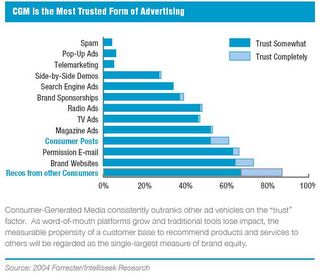Word of Mouth Marketing I: Word of Mouth Versus Traditional Marketing
Word of mouth marketing fuels far more transactions than any other form of advertising. A McKinsey study determined that word of mouth influences “slightly more than two-thirds of the U.S. economy.” Cap Gemini Ernst & Young asked car buyers what influenced them to buy a car and 70% said word of mouth while only 18% attributed it to advertising. There are numerous studies on the impact of word of mouth and they all suggest that word of mouth is about 4-times more effective than any direct (paid) advertising.
Word of mouth works because people trust their friends far more than they trust a paid advertisement. Focus on the degree of “complete trust” in the attached graph.

Most Trusted Form of Advertising

Despite all of this evidence, companies continue to spend ungodly amounts of money on traditional advertising while largely ignoring the power of word of mouth. Why is this? There are a number of reasons as described below:
1. Control
Marketing people cannot control word of mouth marketing, like they can with traditional marketing. Traditional marketing involves crafting a message and then repeatedly slamming that down consumers’ throats at a high cost. Word of mouth marketing involves relying upon your customers to pass their messages to their friends. But you cannot control that message. Sure you can package it for them and spoon feed them, but ultimately they decide what they will tell their friends. This lack of control is very scary to marketing people whose careers are built upon protecting their brand. So the marketing folks fall back on traditional marketing in an effort to control the message and also, hopefully, influence the word of mouth messages.
Counterpoint: By investing time upfront, you can position word of mouth to succeed. Then you need to invest in nurturing it as it grows. You can reinforce the word of mouth messages through traditional advertising, but you need to find out what word of mouth marketing messages are working and then package and reinforce them.
2. Standard
Traditional advertising is the standard. Everybody does it. Just as in the old days, you couldn’t get fired for buying IBM, you can’t get fired for investing in a tried and true marketing medium. Studies show that in the 1970’s the average consumer saw 700 ad messages per day; now they see 3,000 ad messages in a typical day. I probably see (read ignore) 3,000 messages in about an hour of surfing the Net, so undoubtedly, that number needs to be updated to reflect the reality of the web. In any case, advertising is accepted as the standard. The best and most profitable companies in the world spend a ton on traditional advertising. Every company wants to be huge and profitable when they grow up, so they figure they have to invest in standard advertising too, albeit on a smaller scale.
Counterpoint: In response to this barrage of advertising messages, consumers are becoming increasingly numb to it. And as consumers become numb to traditional marketing, word of mouth marketing becomes even more appealing by comparison. This explains why advertising dollars are starting to shift from television (a push media) to the Internet (an increasingly interactive media). The interactivity of the Internet supports word of mouth marketing in a way that the TV never will. Expect more companies to shift their advertising dollars to the Internet as they come to realize what a powerful tool it can be to build word of mouth buzz, and how that translates into offline purchases.
3. Industry Support
Media sales people and advertising companies can provide all sorts of metrics about the return on your advertising dollar using traditional media. But ask them for metrics on word of mouth and they look at you like a deer in the headlights. Despite its impact on the economy there are no standard metrics for quantifying ROI for word of mouth advertising. Of course, this is because most word of mouth is free, there is no financial incentive to build these metrics. This scenario is similar to the vitamin industry. For years Linus Pauling proclaimed the benefits of high-dose vitamin C, but there were few studies on vitamin C because the drug companies have no incentive to fund such studies. Instead drug companies fund research about proprietary drugs that make them a ton of money. Advertising people are the same way.
Counterpoint: Don’t just walk into your bosses office and tell her that you want to invest a certain amount in word of mouth, because most people just assume that word of mouth is free and traditional advertising is where you spend money. Instead, build a plan for starting and fueling positive word of mouth advertising. To most people, the thought of investing in word of mouth advertising is tantamount to buying air. In later installments, I’ll explain how and why you need to invest in building buzz. In lieu of standard ROI graphs, you’ll need a comprehensive plan. Hopefully these posts will also provide supplemental support.
4. Cross Functional Demands
Traditional advertising falls largely under the control of the marketing department. Marketing can create a advertising campaign independently and then deliver it fait accompli to the rest of the organization. Word of mouth relies on a well orchestrated organization working in concert to fuel word of mouth. In some cases your preparation work will highlight organizational weaknesses that must be corrected prior to launching a word of mouth program. If they aren’t fixed they will torpedo the effort. As a result, you’ll need buy-in from the entire organization. This can be daunting, as the saying goes, kind of like herding butterflies. But the rewards can be huge.
Counterpoint: Hey, I write for the “local” market, meaning small businesses. It’s a whole lot easier to implement a company-wide word of mouth program when company-wide means 10 people, than it is when it means 10,000 people. But that aside, you need a comprehensive plan that will garner the support of your CEO, then he can sell it to the organization. If you CEO isn’t capable of doing this, get a new job, your company has no future.
While word of mouth requires a degree of faith, there are many things you can do to create a winning foundation, start it properly and then fuel it in a positive manner. In later installments I will address these next steps, showing you how to prepare your company for word of mouth marketing, launch it and nurture it. In many ways, building word of mouth is like building a bonfire. The first step is to prepare the area. Then you assemble the pieces: match, paper, kindling and large logs. Then you light the fire, not just in one area, but in several areas to ensure success. Finally, you throw additional logs on as necessary to keep it going. This installment explained the value of a word of mouth “bonfire”, later installments will explain the steps for building one.


<< Home